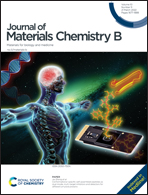PDA-coated CPT@MIL-53(Fe)-based theranostic nanoplatform for pH-responsive and MRI-guided chemotherapy†
Abstract
Theranostic nanoplatforms for multimodal diagnosis and treatment of tumors are a current research hotspot in the field of nanomedicine. MOF-based theranostic nanoplatforms integrating drug delivery with magnetic resonance imaging (MRI) have attracted broad attention in cancer diagnosis and therapy. However, due to the poor chemical and colloidal stability of MOFs, as well as their poor biocompatibility, MOF-based theranostic nanoplatforms still face critical challenges in cancer treatment applications. Here, we devised a theranostic nanoplatform based on a bioinspired polydopamine (PDA)-functionalized metal–organic framework MIL-53(Fe) loaded with camptothecin (CPT) for MRI-guided pH-sensitive chemotherapy. On the nanoplatform, MIL-53(Fe) with good biodegradability has large pore volume and showed a high loading content of antitumor drug CPT (43.07%). To overcome the disadvantages of poor aqueous solubility of MIL-53(Fe) and easy photodecomposition of CPT, the CPT-loaded MIL-53(Fe) was coated with a layer of PDA, resulting in theranostic nanoparticles (PDA@CPT@MIL-53(Fe)). The theranostic nanoparticles exhibited excellent stability and pH-sensitive drug release. In vitro toxicity studies showed that the nanoparticles could be efficiently taken up by breast cancer MCF-7 cells and exhibited high cytotoxicity. In vivo antitumor assay showed the great antitumor effect of the theranostic nanoparticles by using a zebrafish xenograft model. Furthermore, the incorporation of Fe affords the PDA@CPT@MIL-53(Fe) with potential MRI; in vitro MRI showed the nanoparticles exhibit an excellent MRI performance with an r2 value up to 50 mM−1 s−1. These results suggest that CPT-loaded MIL-53(Fe) coated with PDA is a promising theranostic platform for MRI imaging and cancer therapy.



 Please wait while we load your content...
Please wait while we load your content...